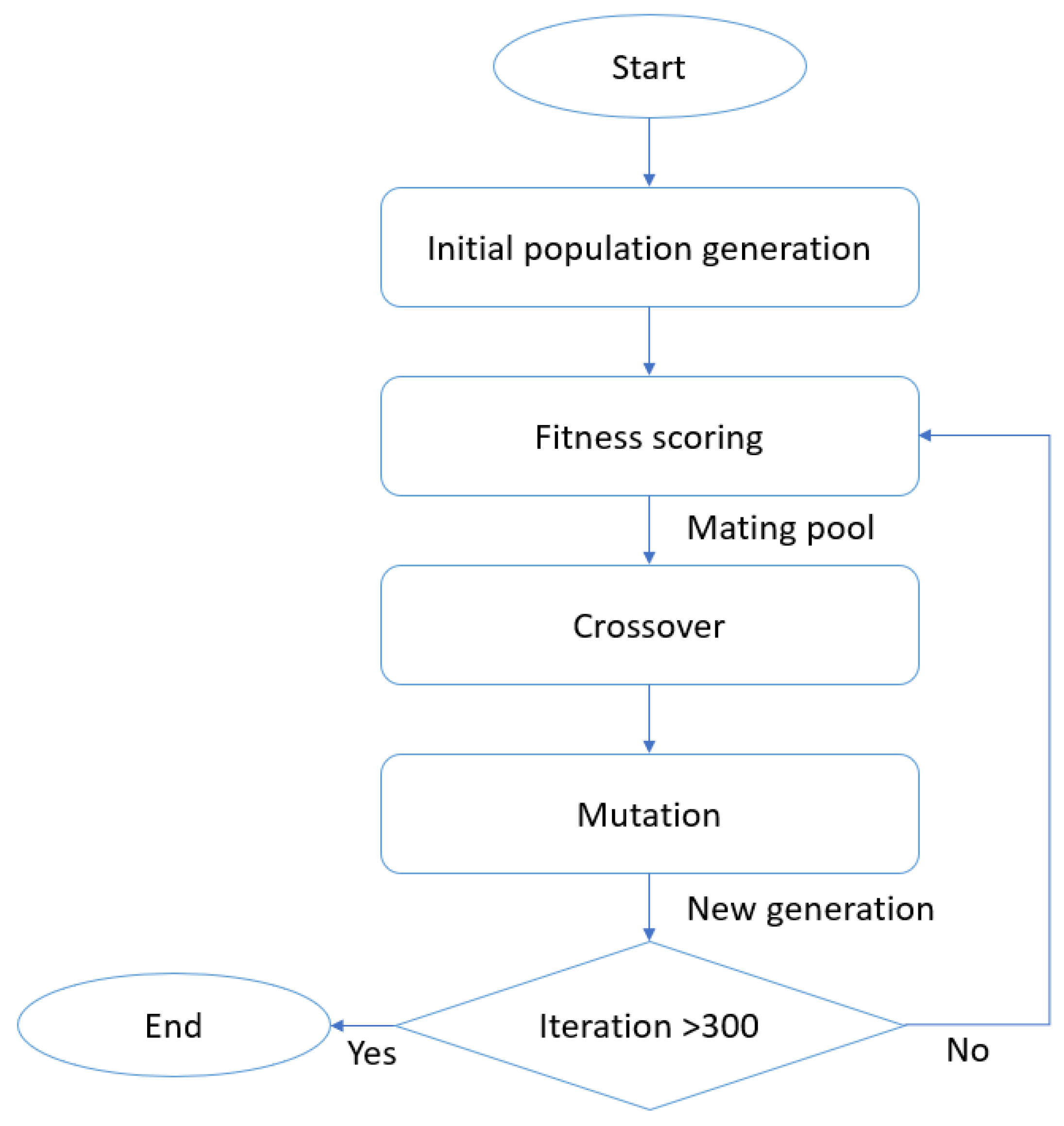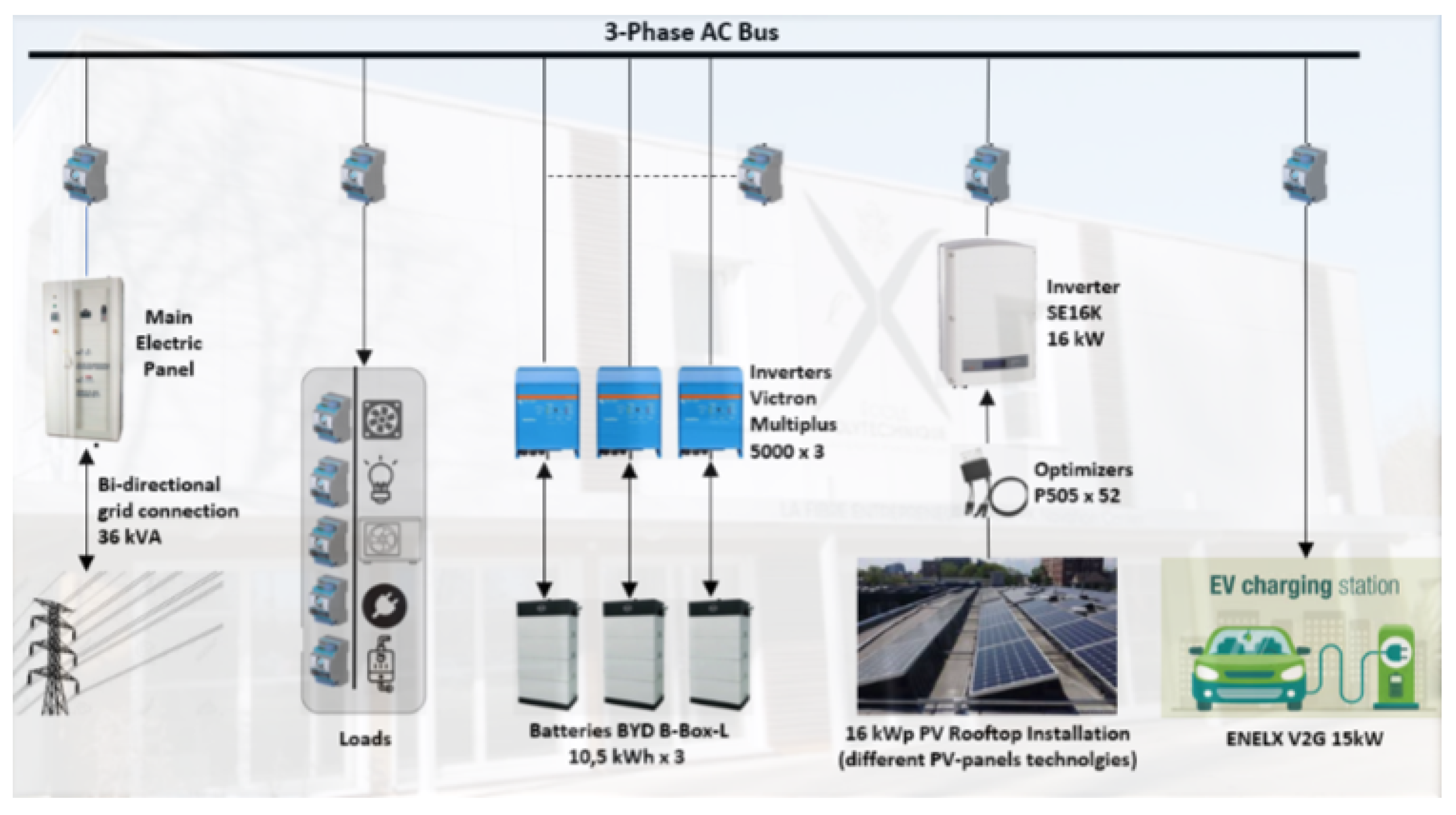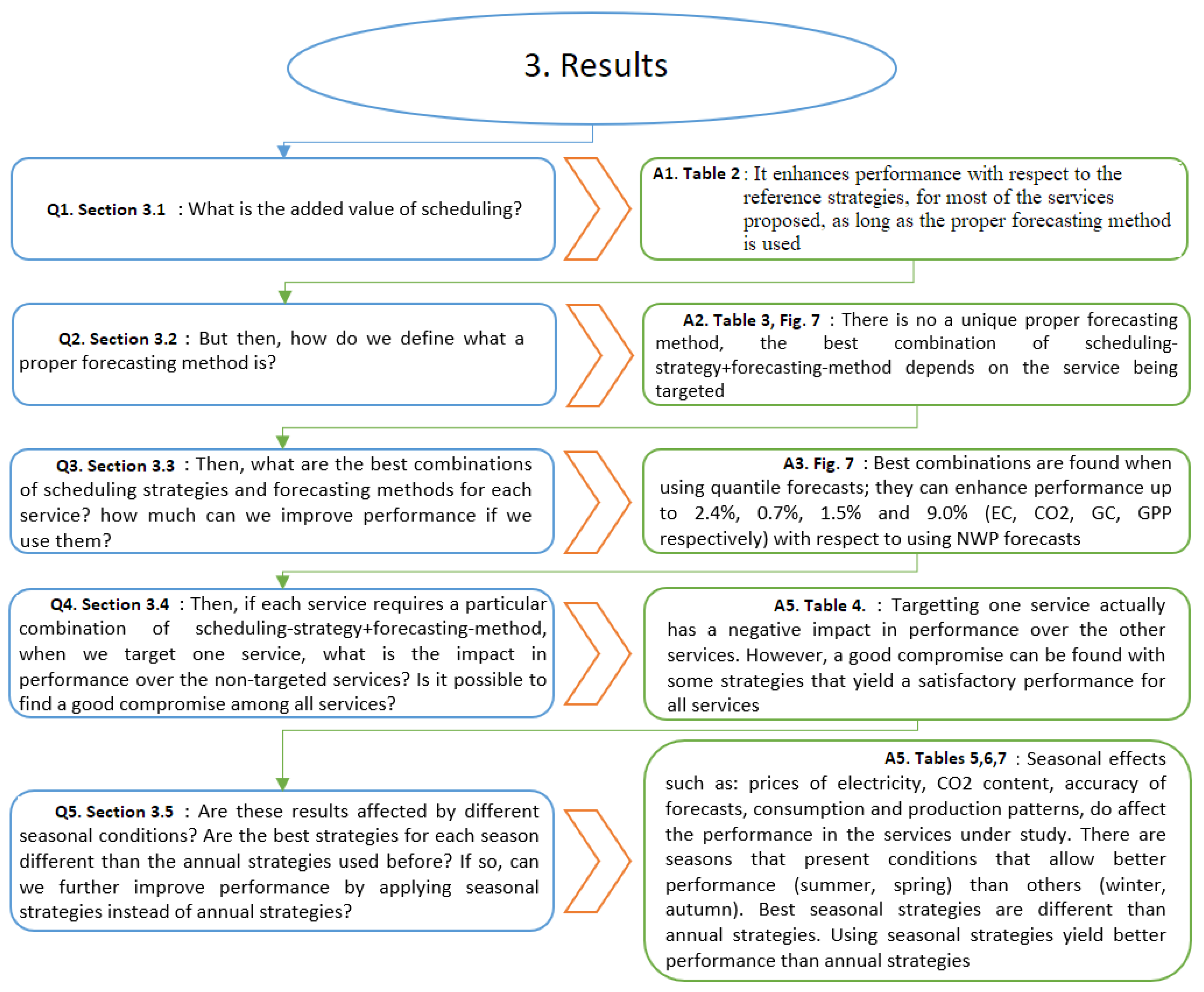A Two-Step Energy Management Method Guided by Day-Ahead Quantile Solar Forecasts: Cross-Impacts on Four Services for Smart-Buildings
Abstract
:1. Introduction
1.1. Energy Management of Microgrids
1.2. Resources Scheduling and Forecasts
1.3. Services in Smart Buildings
- Proposing a service (i.e., grid-commitment), intended to decrease (and serve as a measure of) the degree of uncertainty posed by a microgrid using IRES to the utility grid, regarding its daily power requirements.
- Acknowledging that some services (e.g., grid-commitment) are more favored by eccentric (i.e., pessimistic) forecasts rather than unbiased forecasts.
- The use of quantiles as eccentric (deterministic) forecasts, obtained from an analogs ensembles method, with low computational burdens/time and good performance with respect to benchmark probabilistic forecasting methods.
- Proposing an energy management framework for microgrids, which allow the maximization of the grid-commitment service by means of an underlying rule-based layer, preceded by a day-ahead scheduling optimization-based layer, where another service (i.e., energy cost, carbon footprint, or grid peak power) can be also favored. In this way, the interests of both, microgrid users and distribution system operator, are taken into account during the energy management process.
- Acknowledging that also some external (seasonal) conditions change the forecasting requirements when optimizing for a given service, which again highlights the usefulness of quantile forecasts for customizing optimization/energy management strategies.
2. Materials and Methods
2.1. The Analogs Ensembles Method
2.2. Benchmark Forecasting Methods
2.3. Services and Performance Indicators
2.3.1. Service 1: Reduction in Energy Costs ()
2.3.2. Service 2: Reduction in Electricity Carbon-Footprint (CO)
2.3.3. Service 3: Day-Ahead Power-Commitment with the Utility Grid (GC)
2.3.4. Service 4: Reduction of Grid Contracted-Power ()
2.4. Two-Step Proposed EMS
2.4.1. EMS Scheduling Module
2.4.2. EMS Balancing Module
2.4.3. Reference Strategies
3. Results
3.1. Performance of the Proposed Scheduling Strategies
3.2. Optimistic and Pessimistic Forecasts: The Versatility of Quantile Forecasting
3.3. Optimizing the Services: Finding the Best-Suited Quantile Forecasts
3.4. Impact in Performance of Targeting One Service over the Non-Target Services
3.5. Seasonal Performance Optimization and Analyses
4. Conclusions
Author Contributions
Funding
Acknowledgments
Conflicts of Interest
Appendix A. Nominal and Adjusted Values for Battery and PV Energy
Appendix A.1. Energy Cost Calculations
Appendix A.2. Energy CO2 Content Calculations
Appendix B. Optimization Algorithms

| Penalization Weights | |
|---|---|
| K | 1 × |
| L | 5 |
| M | 1 × |
| Hyper-Parameters | |
| # of Iterations | 300 |
| Population size | 1000 |
| Mutation probability | 100% |
| # of mutating chromosomes | 1 |
| Mating pool size (# of parents) | 100 |
Appendix B.1. Energy Cost Minimization
Appendix B.2. CO2 Content Minimization
Appendix B.3. Grid Peak-Power Minimization
References
- Zia, M.F.; Elbouchikhi, E.; Benbouzid, M. Microgrids energy management systems: A critical review on methods, solutions, and prospects. Appl. Energy 2018, 222, 1033–1055. [Google Scholar] [CrossRef]
- Minchala-Avila, L.I.; Garza-Castañón, L.E.; Vargas-Martínez, A.; Zhang, Y. A Review of Optimal Control Techniques Applied to the Energy Management and Control of Microgrids. Procedia Comput. Sci. 2015, 52, 780–787. [Google Scholar] [CrossRef] [Green Version]
- Kuznetsova, E.; Li, Y.F.; Ruiz, C.; Zio, E.; Ault, G.; Bell, K. Reinforcement learning for microgrid energy management. Energy 2013, 59, 133–146. [Google Scholar] [CrossRef]
- Mbuwir, B.V.; Ruelens, F.; Spiessens, F.; Deconinck, G. Battery Energy Management in a Microgrid Using Batch Reinforcement Learning. Energies 2017, 10, 1846. [Google Scholar] [CrossRef] [Green Version]
- Zhang, D.; Han, X.; Deng, C. Review on the research and practice of deep learning and reinforcement learning in smart grids. CSEE J. Power Energy Syst. 2018, 4, 362–370. [Google Scholar] [CrossRef]
- Reynolds, J.; Ahmad, M.W.; Rezgui, Y.; Hippolyte, J.L. Operational supply and demand optimisation of a multi-vector district energy system using artificial neural networks and a genetic algorithm. Appl. Energy 2019, 235, 699–713. [Google Scholar] [CrossRef]
- Chaouachi, A.; Kamel, R.M.; Andoulsi, R.; Nagasaka, K. Multiobjective Intelligent Energy Management for a Microgrid. IEEE Trans. Ind. Electron. 2013, 60, 1688–1699. [Google Scholar] [CrossRef]
- Herath, A.; Kodituwakku, S.; Dasanayake, D.; Binduhewa, P.; Ekanayake, J.; Samarakoon, K. Comparison of Optimization- and Rule-Based EMS for Domestic PV-Battery Installation with Time-Varying Local SoC Limits. J. Electr. Comput. Eng. 2019, 2019, 1–14. [Google Scholar] [CrossRef]
- Ahmad Khan, A.; Naeem, M.; Iqbal, M.; Qaisar, S.; Anpalagan, A. A compendium of optimization objectives, constraints, tools and algorithms for energy management in microgrids. Renew. Sustain. Energy Rev. 2016, 58, 1664–1683. [Google Scholar] [CrossRef]
- Khodaei, A.; Bahramirad, S.; Shahidehpour, M. Microgrid Planning Under Uncertainty. IEEE Trans. Power Syst. 2015, 30, 2417–2425. [Google Scholar] [CrossRef]
- Li, Z.; Zang, C.; Zeng, P.; Yu, H. Combined Two-Stage Stochastic Programming and Receding Horizon Control Strategy for Microgrid Energy Management Considering Uncertainty. Energies 2016, 9, 499. [Google Scholar] [CrossRef] [Green Version]
- Mazzola, S.; Vergara, C.; Astolfi, M.; Li, V.; Perez-Arriaga, I.; Macchi, E. Assessing the value of forecast-based dispatch in the operation of off-grid rural microgrids. Renew. Energy 2017, 108, 116–125. [Google Scholar] [CrossRef]
- Sachs, J.; Sawodny, O. A Two-Stage Model Predictive Control Strategy for Economic Diesel-PV-Battery Island Microgrid Operation in Rural Areas. IEEE Trans. Sustain. Energy 2016, 7, 903–913. [Google Scholar] [CrossRef]
- Parisio, A.; Wiezorek, C.; Kyntaja, T.; Elo, J.; Johansson, K.H. An MPC-based Energy Management System for multiple residential microgrids. In Proceedings of the 2015 IEEE International Conference on Automation Science and Engineering (CASE), Gothenburg, Sweden, 24–28 August 2015; pp. 7–14. [Google Scholar]
- Liu, G.; Xu, Y.; Tomsovic, K. Bidding Strategy for Microgrid in Day-Ahead Market Based on Hybrid Stochastic Robust Optimization. IEEE Trans. Smart Grid 2016, 7, 227–237. [Google Scholar] [CrossRef]
- Bogaraj, T.; Kanakaraj, J. Intelligent energy management control for independent microgrid. Sādhanā 2016, 41, 755–769. [Google Scholar] [CrossRef] [Green Version]
- Olivares, D.E.; Lara, J.D.; Canizares, C.A.; Kazerani, M. Stochastic-Predictive Energy Management System for Isolated Microgrids. IEEE Trans. Smart Grid 2015, 6, 2681–2693. [Google Scholar] [CrossRef]
- Dou, C.X.; An, X.G.; Yue, D. Multi-agent System Based Energy Management Strategies for Microgrid by using Renewable Energy Source and Load Forecasting. Electr. Power Components Syst. 2016, 44, 2059–2072. [Google Scholar] [CrossRef]
- Adinolfi, F.; D’Agostino, F.; Massucco, S.; Saviozzi, M.; Silvestro, F. Advanced operational functionalities for a low voltage Microgrid test site. In Proceedings of the 2015 IEEE Power Energy Society General Meeting, Denver, CO, USA, 26–30 July 2015; pp. 1–5. [Google Scholar]
- Agüera-Pérez, A.; Palomares-Salas, J.C.; González de la Rosa, J.J.; Florencias-Oliveros, O. Weather forecasts for microgrid energy management: Review, discussion and recommendations. Appl. Energy 2018, 228, 265–278. [Google Scholar] [CrossRef]
- Lezama, F.; Soares, J.; Hernandez-Leal, P.; Kaisers, M.; Pinto, T.; Vale, Z. Local Energy Markets: Paving the Path Toward Fully Transactive Energy Systems. IEEE Trans. Power Syst. 2019, 34, 4081–4088. [Google Scholar] [CrossRef] [Green Version]
- Hvelplund, F. Renewable energy and the need for local energy markets. Energy 2006, 31, 2293–2302. [Google Scholar] [CrossRef] [Green Version]
- Mengelkamp, E.; Notheisen, B.; Beer, C.; Dauer, D.; Weinhardt, C. A blockchain-based smart grid: Towards sustainable local energy markets. Comput. Sci. Res. Dev. 2018, 33, 207–214. [Google Scholar] [CrossRef]
- Global Renewables Outlook: Energy Transformation 2050. 2020. Available online: https://www.irena.org/publications/2020/Apr/Global-Renewables-Outlook-2020 (accessed on 3 April 2020).
- Tao, L.; Mancarella, P.; Hatziargyriou, N.; Buchhoz, B.; Schwaegerl, C.; Strbac, G. European Roadmap for Microgrids. 2010. Available online: https://www.joinup.ec.europa.eu (accessed on 5 April 2020).
- Hatziargyriou, N.D.; Anastasiadis, A.G.; Tsikalakis, A.G.; Vasiljevska, J. Quantification of economic, environmental and operational benefits due to significant penetration of Microgrids in a typical LV and MV Greek network. Eur. Trans. Electr. Power 2011, 21, 1217–1237. [Google Scholar] [CrossRef]
- Strbac, G.; Hatziargyriou, N.; Lopes, J.P.; Moreira, C.; Dimeas, A.; Papadaskalopoulos, D. Microgrids: Enhancing the Resilience of the European Megagrid. IEEE Power Energy Mag. 2015, 13, 35–43. [Google Scholar] [CrossRef] [Green Version]
- Calderon-Obaldia, F.; Le Gal La Salle, J.; Badosa, J.; Lauret, P.; Migan-Dubois, A.; Bourdin, V. Uncertainty estimation for deterministic solar irradiance forecasts based on analogs ensembles. Appl. Energy 2020. under revision. [Google Scholar]
- Alessandrini, S.; Delle Monache, L.; Sperati, S.; Cervone, G. An analog ensemble for short-term probabilistic solar power forecast. Appl. Energy 2015, 157, 95–110. [Google Scholar] [CrossRef] [Green Version]
- Badosa, J.; Gobet, E.; Grangereau, M.; Kim, D. Day-Ahead Probabilistic Forecast of Solar Irradiance: A Stochastic. Renew. Energy Forecast. Risk Manag. 2018, 254, 73. [Google Scholar]
- Haeffelin, M.E.A. SIRTA, a ground-based atmospheric observatory for cloud and aerosol research. Ann. Geophys. 2005, 23, 253–275. [Google Scholar] [CrossRef] [Green Version]
- Tarif Tempo EDF: Grille Tarifaire en 2020 et CGV; Library Catalog, 2018; Available online: Prix-elec.com (accessed on 5 April 2020).
- Eco2mix CO2; Library Catalog, 2014; Available online: Www.rte-france.com (accessed on 10 April 2020).
- Ferruzzi, G.; Cervone, G.; Delle Monache, L.; Graditi, G.; Jacobone, F. Optimal bidding in a Day-Ahead energy market for Micro Grid under uncertainty in renewable energy production. Energy 2016, 106, 194–202. [Google Scholar] [CrossRef]
- Mohamed, F.A.; Koivo, H.N. Multiobjective optimization using Mesh Adaptive Direct Search for power dispatch problem of microgrid. Int. J. Electr. Power Energy Syst. 2012, 42, 728–735. [Google Scholar] [CrossRef]
- Muenzel, V.; de Hoog, J.; Brazil, M.; Vishwanath, A.; Kalyanaraman, S. A Multi-Factor Battery Cycle Life Prediction Methodology for Optimal Battery Management. In Proceedings of the 2015 ACM Sixth International Conference on Future Energy Systems, Bangalore, India, 14–17 July 2015; pp. 57–66. [Google Scholar] [CrossRef]
- Costs and Economics of Electricity from Residential PV Systems in Europe, European Commission Report. 2019. Available online: https://www.europeanenergyinnovation.eu/Articles/Winter-2016/Costs-and-Economics-of-Electricity-from-Residential-PV-Systems-in-Europe (accessed on 4 May 2020).
- Yue, D.; You, F.; Darling, S.B. Domestic and overseas manufacturing scenarios of silicon-based photovoltaics: Life cycle energy and environmental comparative analysis. Sol. Energy 2014, 105, 669–678. [Google Scholar] [CrossRef]
- BYD Li-Ion Batteries. 2020. Available online: https://www.mg-solar-shop.com/byd-b-box-l-10.5-battery-storage-10.5-kwh (accessed on 3 April 2020).
- Majeau-Bettez, G.; Hawkins, T.R.; Strømman, A.H. Life Cycle Environmental Assessment of Lithium-Ion and Nickel Metal Hydride Batteries for Plug-In Hybrid and Battery Electric Vehicles. Environ. Sci. Technol. 2011, 45, 4548–4554. [Google Scholar] [CrossRef] [PubMed]
- Nocedal, J.; Wright, S.J. Numerical Optimization; Springer: New York, NY, USA, 2006. [Google Scholar]








| EMS Strategy | Type | Algorithm | Target Objective | Objective Function/Rules | Possible Forecasts | |
|---|---|---|---|---|---|---|
| Scheduling (SCH) | Optimization based | Genetic | Minimize Energy Cost | See Equation (A11) | PF (Perfect Forecast) PE (Persistence) NWP (Numerical Weather Prediction) | |
| Optimization based | Genetic | Minimize CO2 content | See Equation (A12) | AnEn=0.1−AnEn=0.9 | ||
| Optimization based | Quadratic Programming | Minimize Grid Peak Power | See Equation (A13) | (Analogs-Ensembles quantile forecasts) | ||
| Balancing (BAL) | Rule based | Rules | Maximize Grid commitment | See Figure 5 | No forecasts used | |
| Proposed Strategy | Reference Strategy | Performance | ||
|---|---|---|---|---|
| NO MG | – | Indicator | ||
| -AnEn | −14.5% | −10.3% | −8.8% (AnEn) | EC (€/kWh) |
| -AnEn | +3.3% | −6.0% | −1.6% (AnEn) | (gCO2/kWh) |
| -AnEn | −36.5% | −9.0% | −36.5% (AnEn) | GPP (€) |
| Scheduling Strategy | Performance Indicator | AnEn=0.1 (Pesimistic Forecast) | AnEn=0.9 (Optimistic Forecast) | PE (Unbiased Forecast 1) | NWP (Reference Forecast) | PF (Most Accurate Forecast) |
|---|---|---|---|---|---|---|
| EC (€/kWh) GC (%) | 0.297 99.9 | 0.217 92.1 | 0.176 96.2 | 0.169 99.1 | 0.154 100 | |
| CO (gCO2/kWh) GC (%) | 73 99.9 | 89 88.1 | 65 94.3 | 64 98.5 | 63 100 | |
| GPP (kW) GC (%) | 15 99.7 | 18 90.8 | 15 95.3 | 18 99.1 | 15 100 |
| EMS Intended to: | ECmin-AnEn=0.5 Minimize EC favor GC | CO2min-AnEn=0.3 Minimize CO2 favor GC | GPPmin-AnEn=0.4 Minimize GPP favor GC | ECmin-AnEn=0.1 Minimize EC favor GC | ||||
|---|---|---|---|---|---|---|---|---|
| Performance indicator | % respect | % respect | % respect | % respect | ||||
| to the best: | to the best: | to the best: | to the best: | |||||
| EC (€/kWh) | 0.165 | 0.0 | 0.173 | +4.8 | 0.177 | +7.3 | 0.297 | +80.0 |
| CO2(gCO2/kWh) | 65 | +3.3 | 63 | 0.0 | 64 | +1.9 | 105 | +66.5 |
| GPP (kW) | 30 | +57.4 | 30 | +57.4 | 15 | 0.0 | 30 | +57.4 |
| GC(%) | 98.7 | −1.2 | 99.4 | −0.5 | 99.3 | −0.6 | 99.9 | 0.0 |
| Performance Indicator | Best Winter EMS | Best Spring EMS | Best Summer EMS | Best Autumn EMS |
|---|---|---|---|---|
| EC (€/kWh) | ECmin-AnEn=0.6 | ECmin-AnEn=0.5 | ECmin-AnEn=40:50 | ECmin-AnEn=50:60 |
| CO (gCO2/kWh) | COmin-AnEn=0.3 | COmin-AnEn=0.4 | COmin-AnEn=0.4 | COmin-AnEn=0.1 |
| GPP (kW) | GPPmin-AnEn=0.2 | GPPmin-AnEn=0.2:0.3 | GPPmin-AnEn=0.1:0.8 | GPPmin-AnEn=0.1:0.9 |
| GC (%) | ECmin-AnEn=0.2 | ECmin-AnEn=0.1:0.2 | ECmin-AnEn=0.1 | ECmin-AnEn=0.1 |
| Performance Indicator | Winter | Spring | Summer | Autumn |
|---|---|---|---|---|
| EC (€/kWh) | 0.236 (−1.7%) | 0.114 (−2.6%) | 0.091 (−5.2%) | 0.173 (−2.2%) |
| CO (gCO2/kWh) | 58 (−2.1%) | 53 (−0.6%) | 56 (+1.1%) | 89 (−24.1%) |
| GPP (kW) | 15 (−16.7%) | 12 (0%) | 9 (0%) | 15 (0%) |
| GC (%) | 100 (+0.4%) | 100 (+1.8%) | 100 (+1.6%) | 100 (+0.1%) |
| Performance Indicator | EMS Strategy | |
|---|---|---|
| Seasonal | Annual | |
| EC (€/kWh) | 0.150 (−9.1%) | 0.165 |
| CO (gCO2/kWh) | 62.8 (−0.5%) | 63.1 |
| GPP (kW) | 15 (0%) | 15 |
| GC (%) | 100 (+0.1%) | 99.9 |
Publisher’s Note: MDPI stays neutral with regard to jurisdictional claims in published maps and institutional affiliations. |
© 2020 by the authors. Licensee MDPI, Basel, Switzerland. This article is an open access article distributed under the terms and conditions of the Creative Commons Attribution (CC BY) license (http://creativecommons.org/licenses/by/4.0/).
Share and Cite
Calderon-Obaldia, F.; Badosa, J.; Migan-Dubois, A.; Bourdin, V. A Two-Step Energy Management Method Guided by Day-Ahead Quantile Solar Forecasts: Cross-Impacts on Four Services for Smart-Buildings. Energies 2020, 13, 5882. https://doi.org/10.3390/en13225882
Calderon-Obaldia F, Badosa J, Migan-Dubois A, Bourdin V. A Two-Step Energy Management Method Guided by Day-Ahead Quantile Solar Forecasts: Cross-Impacts on Four Services for Smart-Buildings. Energies. 2020; 13(22):5882. https://doi.org/10.3390/en13225882
Chicago/Turabian StyleCalderon-Obaldia, Fausto, Jordi Badosa, Anne Migan-Dubois, and Vincent Bourdin. 2020. "A Two-Step Energy Management Method Guided by Day-Ahead Quantile Solar Forecasts: Cross-Impacts on Four Services for Smart-Buildings" Energies 13, no. 22: 5882. https://doi.org/10.3390/en13225882





